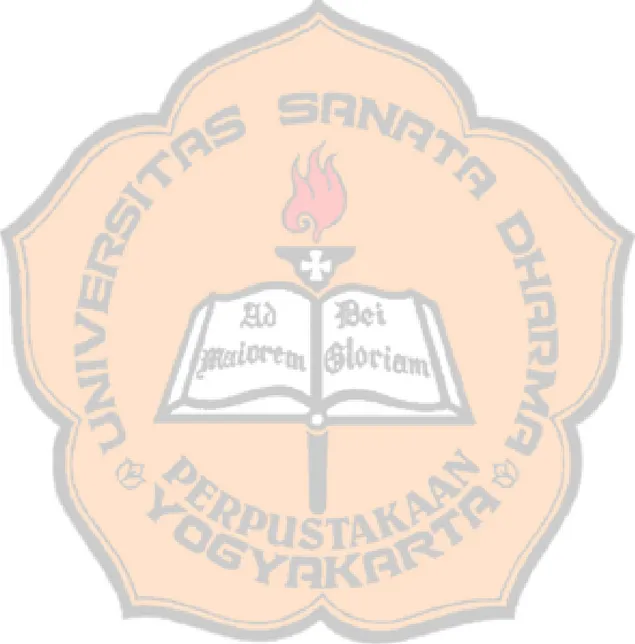THE REBELLION OF ANNA FITZGERALD AGAINST HER PARENTS AS PORTRAYED IN JODI PICOULT’S MY SISTER’S KEEPER
A SARJANA PENDIDIKAN THESIS
Presented as Partial Fulfillment of the Requirements to Obtain the Sarjana Pendidikan Degree
in English Language Education
By
Arum Galih Rahayu Student Number: 111214133
ENGLISH LANGUAGE EDUCATION STUDY PROGRAM DEPARTMENT OF LANGUAGE AND ARTS EDUCATION FACULTY OF TEACHERS TRAINING AND EDUCATION
SANATA DHARMA UNIVERSITY YOGYAKARTA
2017
i
THE REBELLION OF ANNA FITZGERALD AGAINST HER PARENTS AS PORTRAYED IN JODI PICOULT’S MY SISTER’S KEEPER
A SARJANA PENDIDIKAN THESIS
Presented as Partial Fulfillment of the Requirements to Obtain the Sarjana Pendidikan Degree
in English Language Education
By
Arum Galih Rahayu Student Number: 111214133
ENGLISH LANGUAGE EDUCATION STUDY PROGRAM DEPARTMENT OF LANGUAGE AND ARTS EDUCATION FACULTY OF TEACHERS TRAINING AND EDUCATION
SANATA DHARMA UNIVERSITY YOGYAKARTA
2017
THE REBELLION OF ANNA FITZGERALD AGAINST HER PARENTS AS PORTRAYED IN JODI PICOULT'S MY SISTER'S KEEPER
By
Arum Galih Rahayu Student Number: 111214133
Approved by Advisor
Paulus Kuswandono, Ph.D. ~~
u
14 November 2017
THE REBELLION OF ANNA FITZGERALD AGAINST HER PARENTS AS PORTRA YED IN JODI PICOULT'S MY SISTER'S KEEPER
By
ARUM GALIH RAHAYU Student Number: 111214133
Defended before the Board of Examiners on II December 2017
and Declared Acceptable
Board of Examiners
Chairperson : Yohana Veniranda, S.Pd., M.Hum., M.A., Ph.D'<;;1J" '" .
/)
.
Secretary : Drs. Barli Bram, M.Ed., Ph.D.
Member : Paulus Kuswandono, Ph.D.
Member : Yohana Veniranda, S.Pd., M.Hum., M.A., Ph.D "<!1J"
A>Member : Dr. Reina Muljani, M.Pd.
Yagyakarta, II December 2017
Faculty of Teachers Training and Education Sanata Dharma University
Dean
iii
STATEMENT OF WORK'S ORIGINALITY
I honestly declare that this thesis, which I have written, does not contain the work or parts of the work of other people, except those cited in the quotations and the references, as a scientific paper should.
Yogyakarta, 11 December 2017 The Writer
Arum Galih Rahayu ~
111214133
iv
LEMBAR PENYATAAN PERSETUJUAN
PUBLIKASI KARYA ILMIAH UNTUK KEPENTINGAN AKADEMIS
Yang bertanda tangan di bawah ini, saya mahasiswa Universitas Sanata Dharma:
Nama : Arum Galih Rahayu
NomorMahasiswa : 111214133
Dem; pengembangan ilmu pengetahuan, saya memberikan kepada Perpustakaan Universitas Sanata Dharma karya ilmiah saya yang berjudul:
THE REBELLION OF ANNA FITZGERALD AGAINST HER PARENTS AS PORTRAYED IN JODI PICOULT'S MY SISTER'S KEEPER
Dengan demikian saya memberikan kepada Perpustakaan Universitas Sanata Dhanna hak untuk menyimpan, mengalihkan dalam bentuk media lain, menge10lanya dalam bentuk pangkalan data, mendistribusikan secm"a terbatas, dan mempublikasikannya di Internet atau media lain untuk kepentingan akademis tanpa perlu meminta izin dari saya maupun memberikan royalty kepada saya selama tetap mencantumkan nama saya sebagai penulis.
Demikian pemyataan ini saya buat dengan sebenarnya.
Dibuat di Yogyakarta
Pada tanggal: II Desember 2017 Yang menyatakan
Arum Galih Rahayu ~
v


